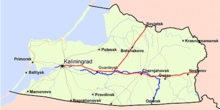Amber Coast



The Amber Coast is the name given to a coastal strip of the Baltic Sea in the northwest of Kaliningrad (Russia, Kaliningrad Oblast, Sambia Peninsula, formerly northern East Prussia in Germany). In this area amber (Baltic amber) has been excavated since the mid-19th century and up to today in open-pit mining. Two deposits – Palmnikenskoe and Primorskoe, containing 80% of world amber reserves, were found near Yantarny on the Western coast of Sambia Peninsula in 1948-1951’s.[1]
History
Scientists believe that amber was deposited during the Upper Eocene and Lower Oligocene in a delta of a prehistoric river, in a shallow part of a marine basin.[2] In addition to the coast near Kaliningrad, amber is also found elsewhere in the Baltic Sea region.[2] The deposits are found mostly in the "blue earth glauconite", a layer 1 to 17.5 meters thick found 25 to 40 meters from the surface.[2] In addition to the Sambia region, amber is gathered in noticeable amounts at German, Polish and Lithuanian Baltic beaches[2] (areas of the Bay of Gdańsk as well as the Vistula Lagoon), the western coast of Denmark[2] and the Frisian Islands.[2] Small amounts of Baltic amber can even be found outside the Baltic region, for example on the coastline of the south east of England.[2]
However, about 90%[3][4] to 98%[2] of all output of amber has been produced in the Sambia region (now a Russian exclave, formerly in Eastern Prussia and the Polish-Lithuanian Commonwealth).[2] The Sambian amber-producing region is a square of about 30–40 km (20–25 miles), although geologists estimate there are deposits beyond the region of the main excavations.[2] A potential nearby source of amber is the Courish Lagoon.[2] Amber excavation is overseen by the Russian Amber Company (Ruskij Jantar).[2][5]
The Amber Coast is mentioned as early as by Tacitus in his work Germania.[6][7]
Other uses
Another coastal strip referred to as “amber coast” is the Costa de Ambar (also known as “Costambar”) in the west of Puerto Plata (Hispaniola, Dominican Republic). In this area there are a number of small shaft mines, from which is excavated the so-called “Dominican amber”.[8] The Dominican amber production site is the world's second largest, although compared to the Baltic region it is "a distant second".[9]
References
- ↑ "The History of Russian Amber, Part 1: The Beginning", Ambery.net
- 1 2 3 4 5 6 7 8 9 10 11 12 Patty C. Rice (15 September 2006). Amber: Golden Gem of the Ages. Patty Rice. pp. 22ff. ISBN 978-1-4259-3849-9. Retrieved 7 March 2011.
- ↑ Gemological Institute of America; American Gem Society (1996). Gems and gemology. Gemological Institute of America. p. 74. Retrieved 8 March 2011.
- ↑ Amber Trade and the Environment in the Kaliningrad Oblast
- ↑ Patty C. Rice (15 September 2006). Amber: Golden Gem of the Ages. Patty Rice. pp. 116ff. ISBN 978-1-4259-3849-9. Retrieved 7 March 2011.
- ↑ K. Andrée: Der Bernstein und seine Bedeutung in Natur- und Geisteswissenschaften, Kunst und Kunstgewerbe, Technik, Industrie und Handel. Königsberg 1937.
- ↑ F. Waldmann: Der Bernstein im Altertum - Eine historisch-philologische Skizze. Fellin 1883.
- ↑ George O. Poinar, Jr.: Life in amber. Stanford 1992
- ↑ "Fossil Amber or Fossil Resin". Virtual Fossil Museum. Retrieved 10 March 2011.
External links
Coordinates: 54°49′37″N 19°57′58″E / 54.827°N 19.966°E